Characteristics of Induced Abortions Reported in Michigan
Division for Vital Records & Health Statistics
Michigan Department of Health & Human Services
![]()
A total of 31,241 induced abortions were reported in Michigan in 2023, which was a 3.7 percent increase from the total of 30,120 reported in 2022 and a 36.4 percent decrease since 1987 (the year with the largest number of induced abortions). (See Number, Ratio and Rate of Reported Induced Abortions Occurring in Michigan, 1982 - 2023.)

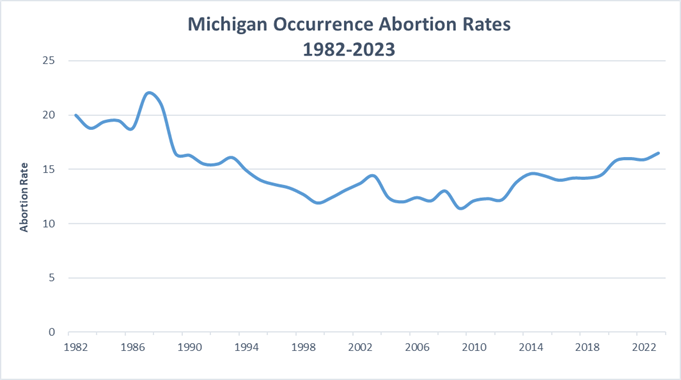
Michigan residents received 91.2 percent of the induced abortions that occurred in Michigan in 2023. This proportion increased 0.4 percent compared with previous years. (See Characteristics of Reported Induced Abortions in Michigan, 1985 - 2023.)
In 2023, 47.9 percent of the resident women receiving abortions had no previous induced abortions. In general, from 1985 through 2023, a gradual increase has been observed with the proportion of women reporting two or more induced abortions, going from 14.6 percent in 1985 to 27.6 percent in 2023. The proportion of women who had no previous induced abortion has generally declined, falling from 59.5 percent in 1985 to 47.9 percent in 2023. (See Characteristics of Reported Induced Abortions in Michigan, 1985 - 2023.)
In 2023, 86.8 percent of the Michigan women who obtained an induced abortion were not married, a 4.4 percent increase from the 82.4 percent reported in 1985. (See Characteristics of Reported Induced Abortions in Michigan, 1985 - 2023.)
65.0 percent of the Michigan resident women obtaining induced abortions in 2023 had a previous term pregnancy. Of the women who had a previous term pregnancy, 60.5 percent in 2023 had at least two or more term pregnancies. (See Number of Reported Induced Abortions by the Number of Previous Pregnancies Carried to Term and Marital Status, Michigan Residents, 2023.)
34.2 percent of Michigan residents receiving induced abortions were under 25 years of age, while 8.1 percent were younger than 20 years old. These are much smaller proportions than the 64.6 and 30.6 percent observed, respectively, in 1985. (See Characteristics of Reported Induced Abortions, 1985 - 2023.)
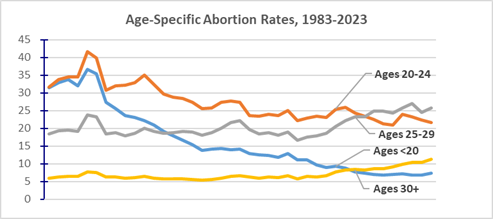
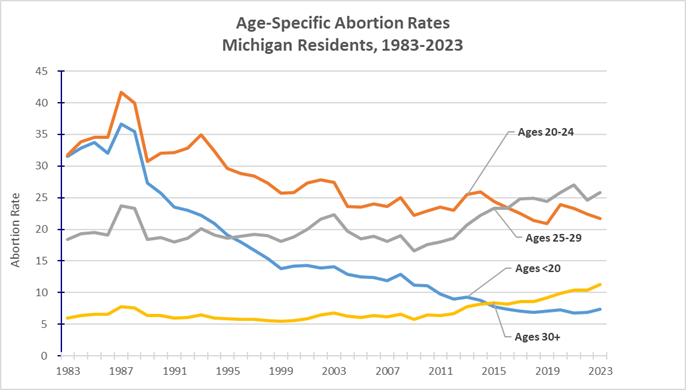
Other than self-referral, which was reported for 89.3 percent of all Michigan resident induced abortions in 2023, the second most frequent source of referral for induced abortion services was a family member or a friend (9.4 percent), followed by a physician (1.0 percent). (See Number of Reported Induced Abortions by Source of Referral and Age of Woman, 2023.)
Among all induced abortions reported in 2023 in Michigan (including both residents and non‑residents), 88.8 percent involved pregnancies of 12 weeks or less. (See Characteristics of Reported Induced Abortions, Michigan Occurrences, 1985-2023.)
Medical (Non-Surgical) and Suction are the two most frequent procedures with 54.9 percent and 38.4 percent respectively among all induced abortions reported in Michigan. (See Number of Reported Induced Abortions by Weeks of Gestation and Principal Procedure, Michigan Occurrences, 2023.)
Starting in 2014, the proportion of induced abortions performed in freestanding clinics increased from 25.1 percent (2013) to 43.9 percent (2014) and 81.5 percent in 2023. In the meantime, the proportion of induced abortions performed in a physician's office decreased from 74.2 percent (2013) to 55.4 percent (2014) and 0.1 percent in 2023. The change of location is almost certainly a result of Act 499 of 2012. The act placed new requirements of abortion providers. (See Characteristics of Reported Induced Abortions, 1985-2023.)
Most abortion reports indicate no immediate complications. In 2023 immediate complications were reported in 16 cases and in a total of 15 cases between 2020-2022. The average three-year rate of 2020-2022 was 1.7 complications per 10,000 induced abortions performed. (See Number and Percent of Reported Induced Abortions with Any Mention of Immediate Complication by Type of Immediate Complication, Michigan Occurrences, 2023.)
In 2023, self-pay was indicated as the source of payment for most induced abortions (97.8 percent). (See Number of Reported Induced Abortions by the Source of Payment and Age of Woman, Michigan Residents, 2023.)
In 2023, ultrasound was the most common method reported for confirming the pregnancy (85.2 percent). (See Number of Reported Induced Abortions by Weeks of Gestation and Method to Confirm Pregnancy, Michigan Occurrences, 2023.)
Information on complications subsequent to an abortion were collected for the first time in 2000. MCL 333.2837 established a separate reporting form for any physician providing care to a woman suffering from a physical complication resulting from an abortion occurring within seven days of the abortion. 247 reports of subsequent complications were submitted in 2023. (See Number of Reported Induced Abortions with Any Mention of Subsequent Complication by Selected Characteristics, Michigan Occurrences, 2023.)
A failed abortion is defined as an abortion attempt that results in an ongoing pregnancy after an attempt at either surgical or medical abortion. In recent years, the number of failed abortions grew to be the most common subsequent complication reported. Starting in 2020, "failed abortion" is listed as an independent category. There are 122 cases reported in 2023. (See Number and Rate of Reported Induced Abortions with Any Mention of Subsequent Complication by Type of Subsequent Complication, Michigan Occurrences, 2023.)
Information on the race of the woman obtaining an induced abortion was collected for the first time in 2003. In 2011, Hispanic ancestry was first collected. Of the Michigan residents receiving abortions in 2023, 53.3 percent were black, 35.0 percent were white, 2.6 percent as other, 2.3 percent were multiracial, 1.8 percent were Asian/Pacific Islander, and 0.6 percent were American Indian. In 2023, 5.2 percent of the women obtaining an abortion were of Hispanic ancestry. (See Number of Reported Induced Abortions by Race of Woman, Michigan Residents, 2023.)
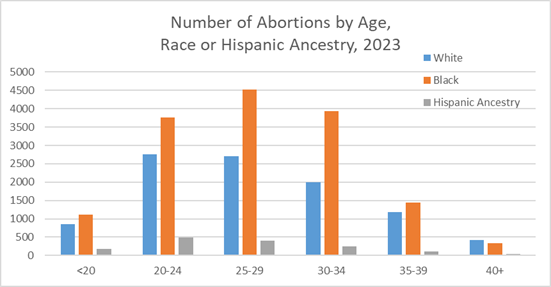
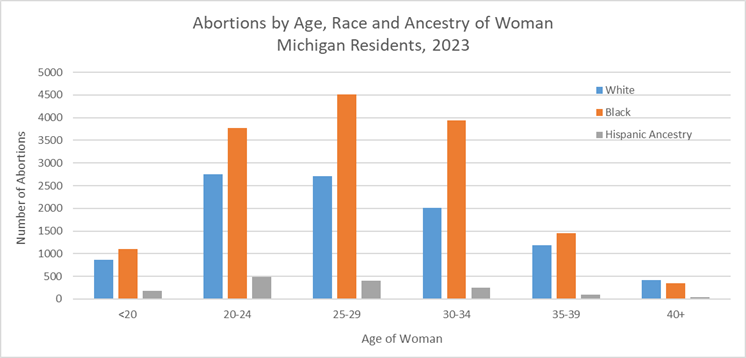
Technical Notes
The
state of Michigan had established a mandatory reporting system for
induced abortions (MCL 333.2835). This reporting system was abolished in February 2024 and this is the final annual report resulting from the mandate.
According to MCL 333.2835, abortion
reports were not allowed to contain any common identifiers that would
make it possible to identify, in any manner or under any circumstances,
an individual who obtained or seeks to obtain an abortion. Abortion
reports were prepared and submitted to the Department of
Health & Human Services by the physician who performed the abortion. The reports were
not legal records; they were used only to produce statistical data
for health and medical purposes. The department was specifically mandated to prepare aggregated statistics of individual abortion reports on an annual basis.
The tables in this report are based on induced abortion reports that were performed from January 1 through December 21, 2023 and received by the Department of Health & Human Services on or
before January 31, 2024. Definitions of the terms used are given
in the footnotes of the individual tables, where necessary.
Important Note: Beginning in 2016, the Michigan Division for Vital Records & Health Statistics changed the standard for gestational age from a calculation based on the last menstrual period, to the obstetric/clinical estimate of gestational age. Abortion statistics based on the obstetric estimate are more comparable to abortion statistics provided by the NCHS and are consistent with the CDC's Induced Termination of Pregnancy guidelines.